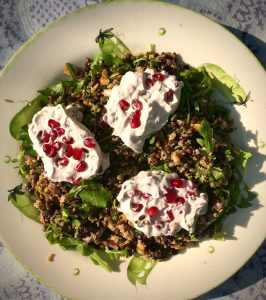I’ve baked this cake a number of times since the summer. The original recipe, a single chocolate ‘Luscious’ cake, is from Naomi Devlin and it stands deliciously alone, as do all her recipes. The list of ingredients may look busy but it’s easy, quick and delicious, three important words for anyone whisking in the kitchen.
My recipe below is a swerve from the original as I’ve been wanting to recreate a gluten-free version of a deeply chocolate-cherry cake my mum used to bake. I also wanted a cake with stilettos for birthdays or Christmas, a two layer cake with a cherry jammy centre and/or whipped cream (here I’ve used Oatly’s dairy-free whippable). Use two 23cm cake tins – or bake one after another if needs must.
This cake still works beautifully without the height. The recipe below is for a single cake so just double the ingredients as per instructions for the stiletto version. You can also do your own swerve and decide on a jam-only centre or jam and cream, up to you.
Most supermarkets sell jars or cans of pitted cherries like morello, so you don’t have to fiddle with removing the pips from fresh ones. Saying that, I did a version with fresh cherries on top and it was scrummy, but do warn guests.

Add sprinkles of something over the chocolate topping, either sieved icing sugar or rose petals or some sugared mini holly and berries which I spied in the cake-baking section of the supermarket. This cake is definitely going to be on our festive menu this year.

An aside about oat cream: even though oat milk/cream contains beta glucans, which helps maintain healthy cholesterol, Oatly cream has a similar saturated fat content to normal dairy whipping cream despite some online info saying otherwise. Also, some blogs state the calories per 100ml are 150, however the Oatly box small print is telling me 253 calories per 100 ml. Is it me needing glasses??
Ingredients for one cake.
Note: Double these if baking a stilletto version
120g white rice flour (brown is fine but a bit heavier)
125g plant milk – I used semi oat
55g diced butter or 45g olive oil
150g light muscovado or caster sugar
60g cocoa powder
3 tsp gf baking powder
1/2 tsp ground psyllium husk
1 tsp sea salt
1 tsp vanilla extract or 2 tsp ground cardamom
1 large egg (Naomi’s original Luscious cake suggests an egg-free version I’ve not tried, hence not here)
125g hot boiled water
One can of pitted cherries (you want to drop about 15 in each cake which leaves some over to add to porridge the next morn, or to the next cake you bake the following week. Refrigerate and store in tight container)
Any cherry (or berry, if you will) jam for the centre
100-125 ml whipped Oatley or dairy cream
Chocolate topping:
100g dark chocolate
3 tsp butter or olive oil
Method
Line a 23cm cake tin or two 23 cm tins if you’re baking a double with jammy/cream filling. You can also use the same tin and bake one cake after another, not energy friendly but it works, and not everyone has two 23 cm tins!
The batter is quite runny so make sure you use tight-fitting tins and line well with baking paper.
Boil the kettle as you’ll need 125g hot water for this cake, plus a cup of your fave tea whilst you’re baking.
Place the rice flour in a heat-proof bowl whilst you heat your plant or regular mylk to almost boiling. Pour the mylk/milk into a jug and add to it 125g boiling water from the kettle.
Pour the hot liquid into the bowl of rice flour and whisk with intention until it’s velvety smooth (Naomi D explains that by doing this you’re ‘precooking the rice to get rid of the rice grittiness.’ )
Add the butter to your hot rice mix and let it gently melt it (or gently stir in the oil) whilst you take another bowl and sieve the dry ingredients: muscovado sugar, cocao, baking powder. Add your salt and ground psyllium husks. Now the smooth rice mixture goes into the dry ingredients then whisk in the egg and vanilla.
Pour the batter into your tin(s) and let them stand whilst you heat the oven to 180C or 350F (fan) or 200C/400F (no fan). Whilst standing the baking powder is apparently beginning to work its wonder.
Bake for approx 35 minutes. To see if it’s done check the edges have pulled slightly away from the tins, and a wooden skewer comes out clean.
If not leave another five or ten minutes.
My cake timings often change depending on whether two cakes are baking at the same time. I’m also convinced seasons play a role in the making, even though the oven temperature is what it is in the baking!
With the stiletto cake, ie. double the above ingredients, and two tins, ensure your jam is spoonable by giving it a short whisk beforehand. Spoon about 4-6 tbsp (very individual) onto one half then use a spatula to gently add the whipped cream.
For the topping, put the broken up dark choc into a bain marie with the butter or oil. Let melt and give a gentle stir to mix – don’t overstir or it may congeal, in which case add a little more butter and briskly whisk.
I use a tablespoon to dollop it onto the top then the back of the spoon to smooth it out on top. I do let some drips of chocolate slide down the sides… but this topping is exactly what the name says and not a siding as well 🙂
Add your sprinkles or sieved icing sugar when the topping is set – and enjoy with your favourite beverage.
Have a merry one!



























